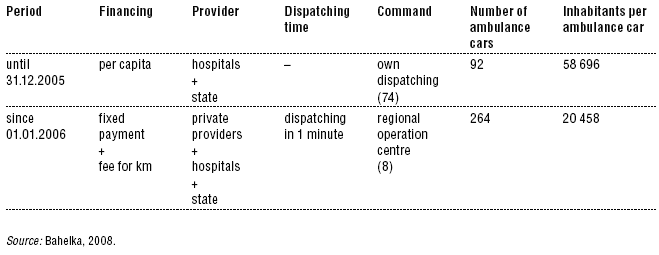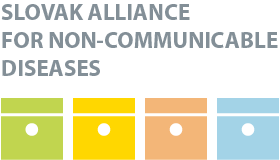—
HPI Network > HPI - Health Policy Institute > Health System in Slovakia > 5. Provision of services > 5.5 Emergency care
5.5 Emergency care
Thursday, 05. May 2011, 1:00 — HPI
| << PREVIOUS
5.4 Inpatient care |
Introduction – Organization – Financing – Resources – Provision – Reforms – Assessment – Conclusions – Appendices |
NEXT >>
5.6 Pharmaceutical care |
Emergency medical services provide urgent care in sudden life-threatening situations. System changes to emergency health care provision adopted in the 2004 health reform have led to an increase in provision, which improved the geographical accessibility of urgent care. Emergency care is now available within 15 minutes of the emergency call in 95% of Slovak territory. In the remaining 5%, emergency care is much more difficult to access. The number of emergency stations has increased from 92, before the health reform, to 264 after the reform took effect (Table 5.2). In 2011, the emergency stations were divided into 118 stations with a physician in the team, 155 stations without a physician and 7 helicopter emergency medical service bases, altogether managed by 27 providers. These providers may be both private and public organizations. They compete in a tender called for by the Ministry of Health for a four-year permit to operate in the stations’ target areas with their personnel and equipment. The geographical location of emergency stations is set by the Ministry of Health. Whereas all other providers have to compete for a contract with the health insurance companies (flexible network), providers of emergency medical service have to be contracted by each health insurance company (fixed network). The details of the emergency medical service are outlined by law. The Ministry of Health determines the payments, which are a combination of a capitation fee for being on stand-by and service fees.
Table 5.2: Basic indicators of emergency medical service reform

Regional emergency centres coordinate and manage emergency medical services and answer emergency calls. They are part of the National Emergency Centre, a contributory organization of the Ministry of Health. The average daily workload of an emergency station was 4.1 interventions per day in 2007. In the same year, the average time needed to reach the site of an event was 11 minutes (Bahelka, 2008).
A 24/7 first aid medical service is a special type of urgent health care provision. Ambulatory physicians work in shifts according to the schedule of the self-governing region. The maximum fee for 24/7 first aid service is government regulated. It is not clearly legally defined and it is not directly linked to the emergency medical service. It does not include home visits by doctors.
Inpatient health care facilities provide urgent ambulatory care as part of inpatient emergency services. The fee for inpatient emergency services is set at €2 per visit, unless the patient is hospitalized. The same fee applies to 24/7 first aid medical service visits.
News
The amendment of the Decree on emergency medical service
Health insurance companies returned over 400 thousand €
The HCSA received 1,647 complaints last year
A half million people will earn more
Most of public limited companies ended in the black
Debt of hospitals on premiums has grown to nearly € 105 MM
Slovak health care may miss € 250 million next year
Profits of HIC amounted to € 69 mil. last year
Owners of Dôvera paid out money but did not paid taxes
Like us on Facebook!
Our analyses
- 10 Years of Health Care Reform
- New University Hospital in Bratislava
- Understanding informal patient payments in Kosovo’s healthcare system
- Analysis of waiting times 2013
- Health Policy Basic Frameworks 2014-2016
- Analysis of informal payments in the health sector in Slovakia
- Serbia: Brief health system review
developed by enscope, s.r.o.
